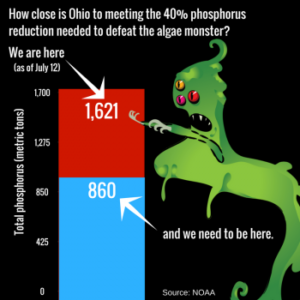Blog
Tagged In: Agriculture, Clean Water, Environmental Health, Farms, Great Lakes, Lake Erie, Water Pollution
Something wicked this way comes: Forecast predicts “severe” algae season
Adam Rissien, June 28, 2017
 Northern Ohio be forewarned: The algae monster looms large this year, according to Lake Erie Harmful Algal Bloom (HAB) Early Season Projection. Although the final projections for this season won’t be announced until early next month, the pre-forecasts are painting a grim picture for the Lake.
Northern Ohio be forewarned: The algae monster looms large this year, according to Lake Erie Harmful Algal Bloom (HAB) Early Season Projection. Although the final projections for this season won’t be announced until early next month, the pre-forecasts are painting a grim picture for the Lake.
Undoubtedly, you are already familiar with this toxic threat. The menace has been looming for years. It can be lethal to small children and pets, and, in 2014, toxic algae infiltrated Toledo’s water supply leaving local residents without safe drinking water for an entire weekend.
But what is the origin story of this horrid blue-green growth, and how can we defeat it?
Algae Monster Origins
The overapplication of phosphorus, through fertilizers and manure, is the largest contributor to the birth of toxic algae and its annual threat. Sometimes this phosphorus stays on croplands, but in rainy seasons it flows into streams and rivers, finally dumping into larger water bodies as runoff pollution. Fertilizers may be good for growing crops, but they’re terrible for our water.
In Northern Ohio, the phosphorus escapes primarily through the Maumee River to Lake Erie’s shallow Western Basin. Once the phosphorus reaches Lake Erie, it morphs into the algae monster we’ve grown to fear. This year, the amount of metric tons of phosphorus nearly equals that of 2014, the year of the Toledo Water Crisis.
Help #DefeatAlgaeMonster
Science has demonstrated that in order to prevent the algae monster from striking Lake Erie year after year, we must cut algae-causing pollution by 40%. Fortunately, some farmers have learned that the conservation practices used to reach this goal reduce their spending, increase their yield, and help the environment.
Unfortunately, as our graphic shows, we are far from this goal. Many industrial scale agriculture and livestock operations, whose phosphorus pollution far exceeds that of any of Ohio’s small farms, still need to get with the program. Ohio’s leaders must take strong action to enforce best-practices for phosphorus reduction on industrial farms. Without these huge operations participating, the reign of the algae monster will continue to haunt Northern Ohio residents, businesses, and visitors.
